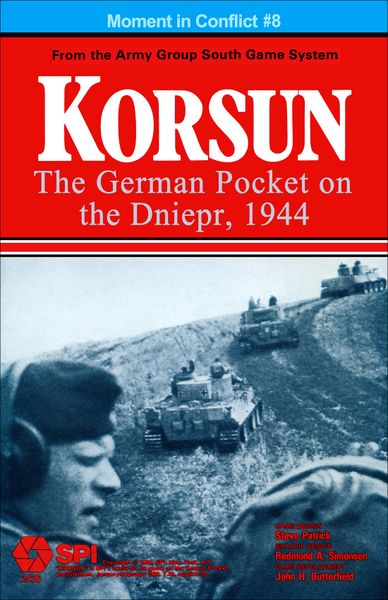Korsun: The German Pocket on the Dniepr, 1944 (1979) Board Game
Brief History and Background Information for Korsun: The German Pocket on the Dniepr, 1944
Korsun: The German Pocket on the Dniepr, 1944 is a wargame that simulates the Battle of the Korsun-Cherkassy Pocket during World War II. The game was released in 1979 and is designed by Redmond A. Simonsen. It allows two players to reenact this historical battle on a hexagon grid board.
Game Components of Korsun: The German Pocket on the Dniepr, 1944
- Hexagon grid board
- Game pieces representing German and Soviet forces
- Rulebook
How To Setup Korsun: The German Pocket on the Dniepr, 1944
- Place the hexagon grid board on a flat surface.
- Each player takes control of either the German or Soviet forces.
- Arrange the game pieces according to the setup instructions in the rulebook.
Gameplay Mechanics and Game Objective
The gameplay involves strategic movement and combat between the German and Soviet forces. Players must utilize their units effectively to outmaneuver and defeat their opponent’s forces. The objective is to either eliminate the enemy forces or achieve specific victory conditions set out in the scenario.
Player Experience
Pros
- Historical accuracy in representing the Battle of the Korsun-Cherkassy Pocket.
- Strategic depth in planning movements and attacks.
- Engaging gameplay for two players interested in World War II history.
Cons
- Limited replay value due to the fixed scenario.
- Learning curve for new players unfamiliar with wargames.
- Components may be outdated compared to modern board games.
Personal Thoughts on Korsun: The German Pocket on the Dniepr, 1944
In my opinion, Korsun: The German Pocket on the Dniepr, 1944 offers a detailed and immersive experience for players interested in historical wargaming. The game provides a challenging simulation of a specific battle in World War II, allowing players to strategize and compete against each other. However, the game’s limited replay value and outdated components may not appeal to a wider audience. Overall, it is worth considering for enthusiasts of the genre, but may not be suitable for casual board gamers.
Game Components
How To Setup Korsun: The German Pocket on the Dnepr, 1944
Setting up the game involves several steps, including referencing the small-scale set-up mapsheet, the Order of Battle table, and a Losses table to delineate the initial state of the forces. This setup requires careful attention to detail, as it involves placing numerous counters on the maps according to the scenario being played. The process can be intricate, often needing multiple sources to ensure correct placement.
Gameplay Mechanics and Game Objective
Player Experience
**Korsun Pocket** is renowned for its high complexity and historical accuracy. Players must manage a plethora of details, making it a challenging but rewarding experience. The game is often described as a “veritable slogging match” due to the meticulous nature of its mechanics. It is advisable for players familiar with large-scale wargames, such as those from SPI, as the rules are detailed and require careful adherence.
Pros
Cons
Personal Thoughts on Korsun: The German Pocket on the Dnepr, 1944
This game is tailored for dedicated wargamers who appreciate historical accuracy and complex gameplay mechanics. It is not for the faint of heart, as it demands a significant investment of time and effort to master. For those who enjoy the depth and complexity of large-scale wargames, **Korsun Pocket** offers a magnificent and immersive experience that recreates the intense and desperate battles of the Eastern Front during World War II. If you’re looking for a game that challenges you and provides a rich historical context, this could be an excellent addition to your collection. However, it is not recommended for casual gamers due to its daunting complexity and extensive playtime requirements.
We are supported by our audience. When you purchase through links on our site, we may earn an affiliate commission, at no extra cost for you. Learn more.

